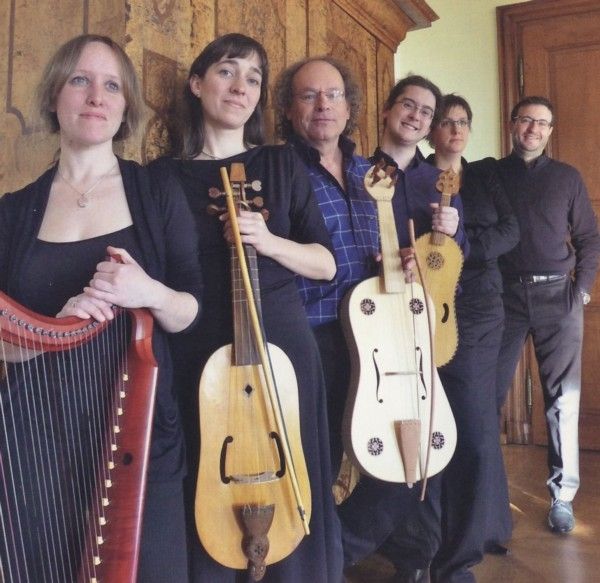Codex Chantilly II
Ensemble Tetraktys
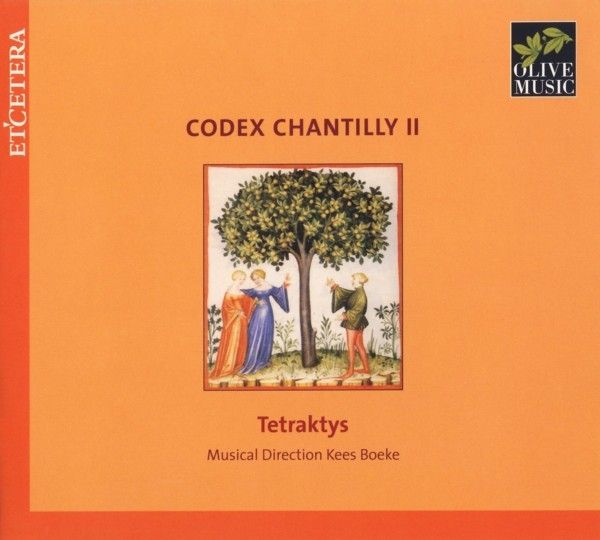
medieval.org
Et'cetera KTC 1905
2011
01 - Toute
clarté [4:30]
ms. fol. 13 · ballade
cantus ZT, harpe KW, vielle ST BR, fluste KB
02 - Jacques de SENLECHES. Fuions de ci [9:48]
ms. fol. 17 · ballade - In or after 1382
cantus ZT, harpe MG, vielle BR KB
03 - VAILLANT. Dame
doucement ~ Doulz amis [4:25]
ms. fol. 26v · rondeau - 1369
cantus ZT, altus CM, harpe MG, vielle BR, fluste KB
04 - SOLAGE. En
l'amoureux vergier [10:50]
ms. fol. 20 · ballade - 1389?
altus CM, harpe MG, vielle BR KB
05 - Guillaume de MACHAULT. De petit po [5:35]
ms. fol. 18v · ballade
cantus ZT, harpe KW, vielle ST, fluste KB
06 - GUIDO. Or voit
tout [10:28]
ms. fol. 25v · ballade
cantus ZT, harpe MG, vielle BR KB
07 - GRIMACE. Se
Zephirus ~ Se Jupiter [7:17]
ms fol. 19 (Fébus) · ballade
cantus ZT, altus CM, harpe MG, vielle BR, fluste KB
08 - Magister FRANCISCUS. Phiton, phiton
[9:07]
ms fol. 20v (Fébus) · ballade
cantus ZT, harpe KW, vielle ST KB
09 - SOLAGE. Tres
gentil cuer [14:38]
ms fol. 18, 50v · virelai
cantus ZT, harpe KW, vielle ST, fluste KB
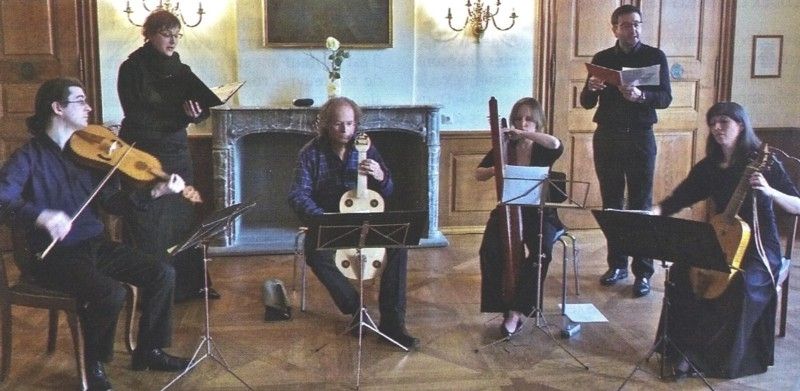
Ensemble Tetraktys
Kees Boeke
Zsuzsi Tóth, cantus #1, 2, 3, 5, 6, 7, 8, 9
Carlos Mena, altus #3, 4, 7
Kirsty Whatley, harpe #1, 5, 8, 9
Marta Graziolino, harpe #2, 3, 4, 6, 7
Silvia Tecardi, vielle #1, 5, 8, 9
Baptiste Romain, vielle #1, 2, 3, 4, 6, 7
Kees Boeke, fluste, #1, 3, 5, 7, 9 · vielle,
#2, 4, 6, 8
Vielles
Maurizio Marcelli, Rieti 1997
Fabio Galgani, Massa Marittima 1996
Judith Kraft, Paris
Harpe
Mario Buonoconto, Maiano 2009: reconstruction after Giovannino de' Grassi and
anonymous fresco on the ceiling of Le Mans cathedral, c.1390
Flustes: Luca de Paolis, l'Aquila
Diapason: 523 Hz
Temperament: Pythagorean
Recorded: 23-25 January and 2-4 May 2010 at the Pieve di San Piet a
Presciano, Arezzo
Production: Jeannette Koekkoek, Kees Boeke
Recording engineer: Valter Neri
Pre-editing: Kees Boeke
Digital editing: Valter Neri
Liner notes: Anne Stone
Design and lay-out: Charlotte Boersma
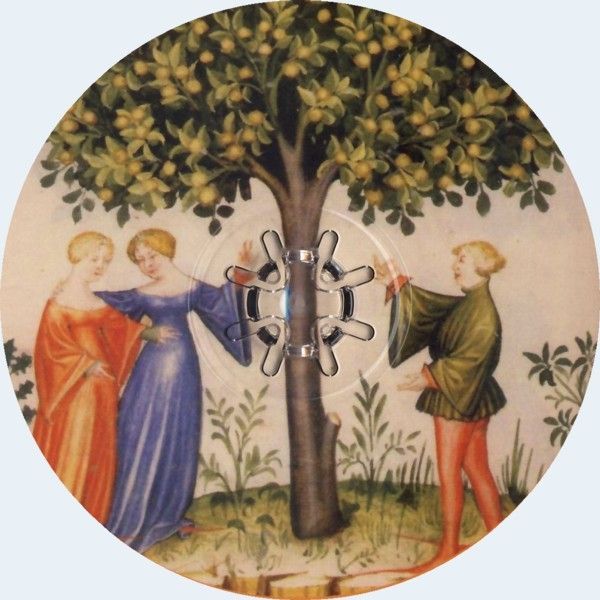
SHORT NOTES
1. This stunning one-strophe Ballade, which opens the second (today
first) gathering of Chantilly, describes how "Fortune" turns everything
upside down: Toute clerté m'est obscure, et toute
beauté laidure et toute joye tristour. It appears
surprisingly also in the Italian Panciatichi Codex which
demonstrates its popularity among a group of exotic French compositions
that found their way into this manuscript.
2. Written for the death of Eleanor d'Aragon, it is therefore dateable
around that date, 1382. Senleches was harpist at the court of Aragon.
3. One of the two double-texted Ballades on this CD, which mentions its
place and date of composition: Paris, 1369. One of the earlier
compositions in Ch.
4. Solage masterpiece based on themes and imagery from the Roman de
la Rose, and probably linked to the marriage of Jean, duc de Berry
with Jeanne de Boulogne in 1389.
5. The extremely popular Machault Ballade about the lady that complains
about her lover leaving her because of gossip that puts her in a bad
light. The morale: he never loved who could hate for so little! This
piece is transmitted in 10 sources other than the Machault manuscripts.
6. One of the two Ballades (the other being "Dieu gart") by a certain
Guido which treat the subject of the contemporary state of composition
and musicianship. Guido favors French notational practices as explained
by Philippe de Vitry over the "measureless and imperfect" art of
Marchetto da Padova.
7. A double-texted love ballade with possible casual reference to
Gaston Fébus; stylistically close to Machault and Andrieu.
8. Phiton is transmitted also in the Codex Reina, but both versions
show highly problematic erroneous passages. We have tried a possible
reconstruction by conflating the material from the two. Doubtlessly
dedicated to Gaston Fébus, this ballade makes reference to
Machaut (by its title), Ovid (mentioned as such) and an anonymous enemy
of "the flour du monde" who might well be Jean, duc de Berry (as such
coined by Solage in his "S'aincy estoit"). The composer, Magister
Franciscus, may in our opinion well be identical with Franciscus
Andrieu, the author of «Armes , Amours» and «De
Narcissus» (see Chantilly Vol.1).
9. The beautiful Machault-oriented poetry is set to very advanced
melodic and harmonic musical language.
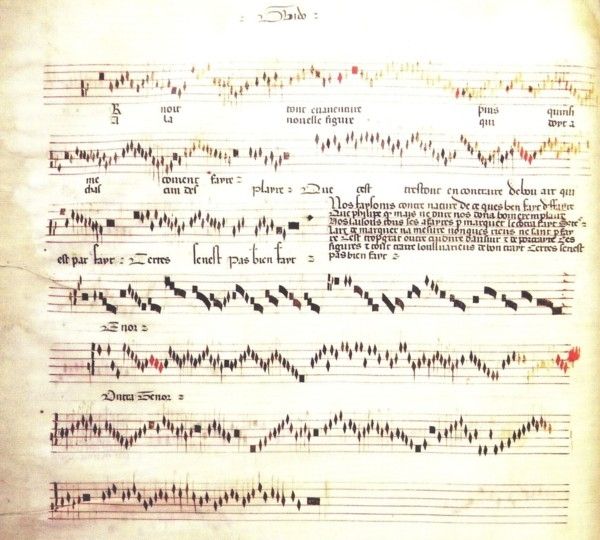
CODEX CHANTILLY vol. 2
The Chantilly codex is the most sumptuous of the manuscripts
transmitting the fascinating polyphonic songs of late
fourteenth-century France in a style known as the "ars subtilior," the
"more subtle art". In the songs of this period, composers exerted
themselves to express ever more complex rhythms, inventing new
notational symbols to express them. The expression of musical rhythm
through notation was such a hot-button issue that a number of songs in
the manuscript actually take it on as a topic, becoming
self-referential essays about musical composition. In addition, the
composers of this music worked in the great courts of Europe, and
politics and political events invariably made their way into the song
repertory.
The music of this codex (which only surfaced in the later nineteenth
century in the hands of a Florentine bookseller) was largely unknown to
scholars until 1950, when the first modern edition appeared edited by
Willi Apel. Apel's colleague at Yale University, Paul Hindemith, wrote
the preface to this edition, and his acute assessment of these
"miraculous microcosms of sound," as he put it, still has resonance
today. He praised the composers for "their distribution of tonal
weight, their cantilever technique of spanning breathtakingly long
passages between tonal pillars ... their unselfish and uninhibited way
of addressing the audience and satisfying the performer; the perfect
adequacy of poetic and musical form; [and] the admirable balance of a
composition's technical effort and its sensual appeal." All of these
attributes, and more, are to be heard in the repertory presented on
this disc.
The oldest composer to be represented in the Chantilly manuscript is
the great Guillaume de Machaut (d. 1377) whose 100 or so songs are
preserved in complete-works manuscripts copied under his supervision.
Of those songs, only a handful appear in other manuscripts of the
period, and the ballade De petit po is one of these, appearing
in ten musical manuscripts and four poetry manuscripts copied mostly in
Italy. The text is in the voice of a woman, lamenting the fact that her
lover has listened to gossip about her and no longer loves her as a
result. The theme of the harm that gossip can do to lovers is a common
one in the courtly love tradition that goes back to the troubadours,
and it is one that Machaut drew upon often in both his songs and his
narrative poetry. This ballade, like many in the period, quotes
proverbs in both its opening line (De petit po de niente volonte)
and its striking refrain: "he never loved who for so little hated." An
educated listener in Machaut's period would thus be treated to the
pleasure of recognizing the quoted proverbs and relishing their use in
a new context.
Two other composers who probably came from an earlier generation than
many in the Chantilly manuscript are Johannes Vaillant and Grimace.
Vaillant is mentioned in a treatise on poetic theory as a poet and
singing master in Paris, and a music theory treatise states that he
taught proportions using the ballade Le sault perilleux, also
found in the Chantilly manuscript. Vaillant's rondeau in the form of
amorous dialogue, Dame doucement/Doulz amis, is notated using a
juxtaposition of sections in red and black ink, which causes a
perceptible shift in the meter from a modern 3/2 to 3/4. The song is
very uncharacteristically given a date of 1369 in the manuscript; if
that date is reliable it makes this song among the manuscript's oldest
after those of Machaut. The other dialogue song recorded here, Se
Zephirus/ Se Jupiter by Grimace, employs the common topos of
invoking names of Greek mythological characters in a conditional
construction ("If
Zephirus...") that ends with the familiar lover's complaint that his
lady will not let him see her. Finally, Phiton, Phiton by the
unknown Magister Franciscus quotes text and music of a ballade by
Machaut, Phiton le mervilleus serpent, but refashions the text
so that the "very poisonous" python is the enemy of Phebus, the common
nickname for Gaston Fébus, Count of Foix (1331-91), who was the
dedicatee of a number of songs found in the Chantilly manuscript.
Phiton, phiton is one of a number of songs in the Chantilly
manuscript that refer directly to real world events in the lives of the
courtly patrons of its composers. The beautiful lament on the death of
Eleanor of Aragon, Queen of Castile, in 1382, by Jacob de Senleches
gives us one of only a few clues to the life of this most interesting
composer. That he was a harpist is known from a single archival notice
that names him as a harpist in the employ of Cardinal Pedro de Luna,
who later would play a major role in the bizarre church politics of the
day as the Avignon Antipope Benedict XIII. Senleches's identity as a
harpist is confirmed by the survival of an extraordinary song, "La
harpe de mellodie," in the shape of a harp whose strings serve as the
staves (this song also appears in the Chantilly manuscript, in regular
staff notation).
The enigmatic Solage (whose name may be either a pseudonym meaning
"solace" or indicate that he hails from one of the myriad villages
called Soulages in the Auvergne) is the best represented composer in
the Chantilly manuscript, with 10 songs ascribed to him. Even though we
are not sure of his name, references in his surviving music suggest
that he was patronized by the great bibliophile and connoisseur of
music, Jean, Duke of Berry. His ballade S'aincy estoit
(recorded by Tetraktys in its first volume of Chantilly songs) is an
extended praise of the Duke, who is named explicitly in its second line
("the good and kind Jean, Duke of Berry") and its refrain pronounces
him the "flower of the world". The two songs recorded in the present
volume, the ballade En l'amoreux vergier and the virelai Tres
gentil cuer, have also been linked to the Duke. En l'amoureux
vergier seems to have been composed along with two other songs in
the Chantilly manuscript for the Duke's wedding in 1389 to Jeanne of
Bolougne. Tres gentil cuer ends with the same text as the
refrain of S'aincy estoit, "the flower of the world",
suggesting that it too was written for the Duke of Berry.
The exciting and fractious world of musical composition is invoked in
two songs recorded here. In the first one, the anonymous Tout
clarté, the reference is subtle: the poetic speaker
describes a world of reversals in which everything clear is obscure and
all joy is sadness. This because he is unable to see "the figure,"
meaning both the lady whom he loves but also the written note shapes
that the composer uses to write his music down. The reversal of the
world described by the speaker is reflected in the striking reversal of
voice parts in the opening phrase of the song, in which the cantus, the
highest voice, descends through a long passage to close an octave below
its opening note, while the tenor ascends to cadence above it. Finally,
the exceptionally clever Or voit tout en aventure by a composer
named only as Guido, to whom only one other song is attributed, decries
the state of music in his time: everything has gone to hell because
composers are constrained to use the new notational symbols ("figures"
again) that no one likes and that "have no measure," or make no sense.
The delightful irony of this song, an irony that is available only to
listeners who can also look at the manuscript, is that the song is
written using the very note shapes that its text complains about. The
Chantilly manuscript is indeed a document that must be prized both for
the sonic beauty of its songs and the visual beauty of their written
presentation, making it one of the first multimedia objects of western
European history.
Anne Stone
